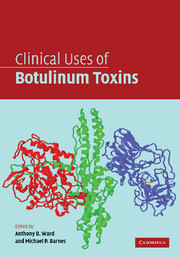Book contents
- Frontmatter
- Contents
- List of Contributors
- 1 Introduction
- 2 Mechanistic basis for the therapeutic effectiveness of botulinum toxin A on over-active cholinergic nerves
- 3 Botulinum toxin: from menace to medicine
- 4 Botulinum toxin: primary and secondary resistance
- 5 Introduction to botulinum toxin in clinical practice
- 6 Cervical dystonia
- 7 The use of botulinum toxin in otolaryngology
- 8 Spasticity
- 9 Hyperhidrosis
- 10 Hypersalivation
- 11 Botulinum toxin type A for the prophylactic treatment of primary headache disorders
- 12 Botulinum toxin in the management of back and neck pain
- 13 Clinical uses of botulinum toxin
- 14 Bladder and bowel indications
- 15 Cosmetic uses of botulinum toxin A
- 16 Other clinical neurological uses of botulinum toxin
- Index
- Plate section
- References
6 - Cervical dystonia
Published online by Cambridge University Press: 02 December 2009
- Frontmatter
- Contents
- List of Contributors
- 1 Introduction
- 2 Mechanistic basis for the therapeutic effectiveness of botulinum toxin A on over-active cholinergic nerves
- 3 Botulinum toxin: from menace to medicine
- 4 Botulinum toxin: primary and secondary resistance
- 5 Introduction to botulinum toxin in clinical practice
- 6 Cervical dystonia
- 7 The use of botulinum toxin in otolaryngology
- 8 Spasticity
- 9 Hyperhidrosis
- 10 Hypersalivation
- 11 Botulinum toxin type A for the prophylactic treatment of primary headache disorders
- 12 Botulinum toxin in the management of back and neck pain
- 13 Clinical uses of botulinum toxin
- 14 Bladder and bowel indications
- 15 Cosmetic uses of botulinum toxin A
- 16 Other clinical neurological uses of botulinum toxin
- Index
- Plate section
- References
Summary
Introduction
The term dystonia is defined as a sustained, involuntary contraction of muscle that produces an abnormal posture and frequently causes twisting and turning. Cervical dystonia is the most common form of adult-onset focal dystonia. It is defined as involuntary twisting and turning of the neck caused by abnormal involuntary muscle contractions. This abnormal posture may be associated with spasms, jerks or tremors or a combination of these features. Cervical dystonia also has been referred to as spasmodic torticollis but this term does not reflect the dystonic nature of the problem. It implies that spasms are an essential feature of the disease although these can be absent in 25–30 per cent of the patients with cervical dystonia. Torticollis on the other hand is the physical sign of the twisted neck and may result from many non-dystonic causes.
It is well known that due to variable presentation of this disease cervical dystonia is frequently misdiagnosed and accurate diagnosis is often delayed. The aetiology and pathogenesis of cervical dystonia remains unclear. However it is generally agreed that genetic factors, trauma, altered sensory input, primary vestibular abnormality and impaired basal ganglia function may all have some role in the development of this disease. Adult-onset cervical dystonia usually does not become generalized although there may be segmental spread with involvement of arms jaws or trunk. A small percentage of patients can have a spontaneous remission but it is usually short lived and incomplete.
- Type
- Chapter
- Information
- Clinical Uses of Botulinum Toxins , pp. 80 - 110Publisher: Cambridge University PressPrint publication year: 2007

